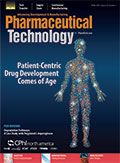Spray Drying: Supporting Patient-Centric Drug Development
Pharmaceutical Technology Europe spoke with Manuel Leal, business development director for Idifarma to learn more about spray drying and how it can support patient-centric drug development.
Editor's Note: This article was published in Pharmaceutical Technology Europe's April 2019 print issue.
There are multiple issues, including solubility, that can plague drug development. As more poorly aqueous soluble compounds are entering development, industry is witnessing increased popularity in a range of techniques that may overcome solubility issues.
One such technique is spray drying, which is expected to experience continued growth as a result of efficiency rates and improvement in stability of products (1). To learn more about spray drying and how it can support patient-centric drug development, Pharmaceutical Technology Europe spoke with Manuel Leal, business development director for Spanish contract development and manufacturing organization, Idifarma.
PTE: Can you briefly overview spray drying and how it may be used to overcome specific formulation challenges?
Leal (Idifarma): Spray drying offers a unique solution to some of the most demanding formulation challenges posed to the pharmaceutical industry, such as solubility, stability, and bioavailability.
It involves spraying a solution or suspension that contains the active substance and the corresponding excipients inside a drying chamber. As the solvent is evaporated at high speed, dry particles are dispersed and collected by a cyclone. Particles obtained after spray drying are amorphous solid dispersions with different particle sizes, achieving better solubility than the API alone.
Around 40% of all new chemical entities (NCEs) have low water solubility, meaning a strategy for improving poor bioavailability becomes mandatory.
There has also been a growing difficulty to find new drugs that improve existing therapies, therefore the need to use innovate processes, such as spray drying, to advance the galenic formulation of the finished product is vital. Using such technologies means the industry is no longer reliant on finding new active molecules.
PTE: What are the benefits of spray drying over other technologies/solutions?
Leal (Idifarma): Spray drying operates on a continuous production process; therefore, batch size is not limited by the equipment capacity common with other technologies. This means that spray drying presents a scalable and cost-effective solution as it is a rapid and easily repeatable process.
Spray drying lends itself more favourably to certain drug products. The technology allows control over particle size and morphology in one single process, which is particularly useful for drugs for inhaled administration. It also suits temperature sensitive molecules, as the product spends less time exposed to heat compared with other processes.
PTE: How can spray drying support patient-centric drug development/formulation?
Leal (Idifarma): Spray drying can support patient-centric drug development in a variety of ways, from modifying the release of the active substance to changing the administration route to aid patient compliance.
Adherence or compliance problems are apparent within many chronic therapies, which might result in a lower therapeutic effect of the treatment. Yet, the development of dosage forms allowing a prolonged release of the active substance can improve therapeutic compliance by reducing the number of times a patient has to take the medication.
Enhancing a dosage form is even more relevant with intravenous pharmaceutical forms, because of the reduction of needle punctures the patient needs to receive in long-term treatments. Spray drying enables the manufacture of modified release intermediates for several pharmaceutical forms including tablet, capsule, powder inhalation, and IV solutions.
Another interesting application is that spray drying can facilitate different administration routes by changing the pharmaceutical form of the finished product. By improving the solubility and bioavailability, drugs with parenteral administration could be administered by oral route. This improves comfort for the patients, allowing them to take the drugs at home. Plus, the costs associated with the administration of a product at a hospital and manufacturing sterile products are avoided.
The benefits of this technology are particularly compelling for orally administered drugs because more problems related with this route can be resolved. One way is that drugs that had been incompatible with food intake can be encapsulated and released in another part of the gastrointestinal tract, avoiding the food effect and simplifying the delivery of the drug for the patient.
In addition, with the microencapsulation of the active substance, a lower degradation of the drug at a gastric level can be reached and so, in some cases, it is possible to lower the strength administered to the patient.
And finally, spray drying can also support patient compliance through taste-masking, as bad tastes are common in a lot of active substances. Overcoming this using spray drying technologies can also directly impact the comfort of the patient taking the product, and therefore in therapeutic compliance.
PTE: What specific requirements are important when selecting a spray drying partner?
Leal (Idifarma): As well as the standard requirements, such as experience, competitive costs, and corresponding official certifications, there are additional aspects to consider when selecting the right spray drying partner.
Companies should take into account a potential partner’s ability to work with a specific profile of molecules (particularly that of highly potent molecules), whether they can handle the required volumes, and if they have the capacity to perform galenical trials, as these are all important factors.
Any chosen provider must have a flexible corporate structure and be experienced in project management, so they can easily resolve problems using their experience and capabilities in complex pharmaceutical developments. They should also look for a provider who does not have its own portfolio of products to avoid any potential conflict of interests.
Reference
1. Persistence Market Research, “Pharmaceutical Spray Drying Market: Global Industry Analysis and Forecast to 2020,” Report.

Drug Solutions Podcast: A Closer Look at mRNA in Oncology and Vaccines
April 30th 2024In this episode fo the Drug Solutions Podcast, etherna’s vice-president of Technology and Innovation, Stefaan De Koker, discusses the merits and challenges of using mRNA as the foundation for therapeutics in oncology as well as for vaccines.